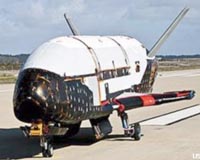 |
Washington (AFP) Dec 3, 2010 The shuttle Discovery's final mission to the International Space Station will be delayed until February 3 at the earliest as engineers try to solve the mystery of the cracked fuel tank, NASA said Friday. The aging shuttle's latest attempt to launch was scratched on November 5 when technicians found a hydrogen leak and later a series of long cracks on the shuttle's external fuel tank. But engineers remain stumped as to how or why they emerged, meaning the shuttle Discovery will stay grounded until next year, pushing back the last shuttle flights before the fleet is retired to spring and summer. "When this problem first occurred, we were expecting to find an obvious problem, some kind of a flaw in the material, some kind of crack that had been missed in the construction of the inner tank area," said space shuttle program manager John Shannon. "And as we have gone through the investigation we are not finding that obvious flaw or that obvious problem." Experts are puzzled by the cracks that were found on a pair of 21-foot-long (6.5 meter) U-shaped aluminum brackets called stringers on the shuttle's external tank. Analyses so far have shown there there were no initial cracks in the brackets that were made worse during the fueling process, so engineers are trying to determine what could have caused stress on the brackets during assembly and loading. "We have to take the next step," said Shannon. "We have to look in greater detail at what kind of stresses you can put on these stringers." However NASA was optimistic that the problem would be fixed in time for a February launch. "I have strong confidence that this is a solvable problem," Shannon said. The early February launch window stays open until the 10th, and if no launch can occur in that timeframe, the next window opens February 27 through March 3. The shuttle Endeavour, which is the last official shuttle launch scheduled for the US program, is set to launch in April. NASA's recently approved 2011 budget has left the door open to an additional shuttle flight in June, but that mission, STS 135, remains uncertain. Congress has approved funding for STS 135, but it faces further review by Congressional appropriators. NASA experts said Friday the postponements of Discovery and Endeavour were not likely to impact that third and final mission. "We believe that if we fly an STS 135 mission, then June is still a real possibility for that, or there are other options later in the summer," said Shannon. Discovery's 11-day mission with its all-American crew of six is to deliver a pressurized logistics module called "Leonardo" to the ISS, which will be permanently attached to the space station to provide more storage space. The shuttle will also bring Robonaut 2, the first human-like robot in space and a permanent addition to the orbiting space station, as well as spare parts. Two space walks, for maintenance work and component installation, are scheduled. The Discovery has launched into space 38 times, and NASA aims to retire the shuttle after its final and 39th voyage. The launch was intended to be the fourth and final shuttle flight of the year and the last scheduled for Discovery, the oldest in a three-shuttle fleet that is being retired next year. But the Discovery mission has been marred by a series of delays brought on by bad weather and equipment problems. The three US shuttles -- the other two are Atlantis and Endeavour -- are due to become museum pieces once the final shuttle mission takes place. Then, the Russian Soyuz spacecraft -- a modernized version of which recently dropped off three fresh crew members to the ISS, doubling the crew to six -- will for several years be the only vehicle for transporting humans into space.
Share This Article With Planet Earth
Related Links Shuttle at NASA Watch NASA TV via Space.TV Space Shuttle News at Space-Travel.Com
 US military space UAV back on ground after 7 month mission
US military space UAV back on ground after 7 month missionWashington (AFP) Dec 3, 2010 An unmanned US Air Force spacecraft with a vaguely defined military mission landed early Friday in California after a seven-month mission, officials said. The X-37B, the US Air Force's first unmanned re-entry spacecraft, landed at Vandenberg Air Force Base at 1:16 am local time (0932 GMT), according to an Air Force statement. The orbital spacecraft "conducted on-orbit experiments for mor ... read more |
|
| The content herein, unless otherwise known to be public domain, are Copyright 1995-2010 - SpaceDaily. AFP and UPI Wire Stories are copyright Agence France-Presse and United Press International. ESA Portal Reports are copyright European Space Agency. All NASA sourced material is public domain. Additional copyrights may apply in whole or part to other bona fide parties. Advertising does not imply endorsement,agreement or approval of any opinions, statements or information provided by SpaceDaily on any Web page published or hosted by SpaceDaily. Privacy Statement |